

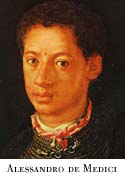 Despite the many portraits of this 16th century Italian Renaissance figure,
his African heritage is rarely, if ever, mentioned.[Editor's Note: For more
on this omission as it has occurred in the art world, read this January 2005
update.]
Despite the many portraits of this 16th century Italian Renaissance figure,
his African heritage is rarely, if ever, mentioned.[Editor's Note: For more
on this omission as it has occurred in the art world, read this January 2005
update.]
Alessandro wielded great
power as the first duke of Florence. He was the patron of some of the leading
artists of the era and is one of the two Medici princes whose remains are
buried in the famous tomb by Michaelangelo. The ethnic make up of this Medici
Prince makes him the first black head of state in the modern western world.
Alessandro was born in 1510 to a black serving woman in the Medici household
who, after her subsequent marriage to a muleteer, is simply referred to in
existing documents as Simonetta da Collavechio. Historians today are convinced
that Alessandro was fathered by the seventeen year old Cardinal Giulio de
Medici who later became Pope Clement VII. Cardinal Giulio was the nephew of
Lorenzo the Magnificent.
On being elected Pope in 1523, Cardinal Giulio was forced to relinquish the
lordship of Florence but he appointed a regent for his thirteen year old son
Alessandro who had just been created Duke of Penna, and a nephew, Ipollito.
Even though both were bastards, they were the last of what has come to be
referred to as the elder line of the family.
Republicanism had grown in Florence under the regent and when Emperor Charles
V sacked Rome in 1527, the Florentines took advantage of the situation to
install a more democratic form of government and both Alessandro and Ipollito
fled. When peace was finally made two years later between the Papal and the
Imperial factions, Charles V agreed to militarily restore Florence to the
Medici. After a siege of eleven months Alessandro was finally brought back as
the Emperor's designated head of state.
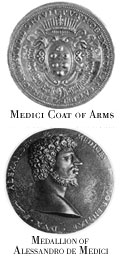 In 1532, the new Florentine constitution declared Alessandro hereditary Duke
and perpetual gonfalonier of the republic. Though his common sense and his
feeling for justice won his subjects' affection, those in sympathy with the
exiled opposition hated Alessandro and accused him of using his power to
sexually exploit the citizenry. However, only two illegitimate children with
the possibility of a third, have been attributed to him and even these he
fathered with one woman, Taddea Malespina, a distant cousin of his.
In 1532, the new Florentine constitution declared Alessandro hereditary Duke
and perpetual gonfalonier of the republic. Though his common sense and his
feeling for justice won his subjects' affection, those in sympathy with the
exiled opposition hated Alessandro and accused him of using his power to
sexually exploit the citizenry. However, only two illegitimate children with
the possibility of a third, have been attributed to him and even these he
fathered with one woman, Taddea Malespina, a distant cousin of his.
With the death of his father, the Pope, in 1534, the exiles attempted to oust
the Duke Alessandro from Florence. But the Emperor decided to uphold Alessandro
and in an obvious show of support, gave Alessandro his own illegitimate
daughter, Margaret of Austria, as wife.
Despite the security this kind of support should have given him, Alessandro was
finally assassinated a few months after his wedding by Lorenzaccio de Medici, a
distant cousin who had ingratiated himself in order to win his confidence.
According to the declaration he later published, Lorenzaccio claimed that he
had executed Alessandro for the sake of the republic and that he had been able
to disarm him of his personal bodyguards by setting up a sexual liaison for him
as a trap. When the anti-Medici faction failed to use this occasion to
overthrow the ducal government, Lorenzaccio fled in dismay. He was himself
eventually murdered some twelve years later.
Allessandro's Children:
Although the initial reaction to the assassination on the part of the Ducal
party had been to set up a regency for Alessandro's four year-old son, Giulio,
they instead turned to Cosimo of the cadet branch of the family who as young
man of seventeen they felt would be able to bring some equilibrium to the
political instability that confronted them.
Since they were his cousins and since Cosimo had to consolidate the authority
of the Medici family, Cosimo raised Alessandro's children in his own household
and continued as their guardian until adulthood. Despite the awkward presence
at his court of a potential pretender to the duchy of Florence, Cosimo
apparently regarded his young wards with true affection.
Giulio married Lucrezia Gaetani in 1561 and a year later, Cosimo appointed him
First Admiral of the Knights of San Stephano, an order especially founded to
fight the Turks.
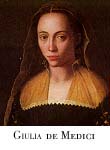 Giulio's sister, Giulia, was first married to Francesco Cantelmo, the Count of
Alvito and the Duke of Popoli. When her husband died unable to give her
children a few years later, Cosimo then married Giulia off in 1559 to a first
cousin of his, Bernardino de Medici. Apparently Giulia's pride in her Medici
ancestry was intense. In the early years of her second marriage, her
insistence that she be treated at court as the equal of Cosimo's wife caused a
rift between herself and Cosimo. Eventually she and her husband moved to
Naples where, at an enormous expense to themselves, they acquired both the
title and lands of the principality of Ottaiano. (Click
here for more on Giulia
and "Giulia's Portrait." Also, read the November 2001 Washington Post article on the race issue controversy over a portrait of Giulia.)
Giulio's sister, Giulia, was first married to Francesco Cantelmo, the Count of
Alvito and the Duke of Popoli. When her husband died unable to give her
children a few years later, Cosimo then married Giulia off in 1559 to a first
cousin of his, Bernardino de Medici. Apparently Giulia's pride in her Medici
ancestry was intense. In the early years of her second marriage, her
insistence that she be treated at court as the equal of Cosimo's wife caused a
rift between herself and Cosimo. Eventually she and her husband moved to
Naples where, at an enormous expense to themselves, they acquired both the
title and lands of the principality of Ottaiano. (Click
here for more on Giulia
and "Giulia's Portrait." Also, read the November 2001 Washington Post article on the race issue controversy over a portrait of Giulia.)
The greater majority of the noble houses of Italy can today trace their
ancestry back to Alessandro de Medici. And, as shown in the two lines of
descent to the Hapsburgs drawn up below, so can a number of other princely
families of Europe:
Giulio de Medici, (Allessandro's son) Knight Commander of the Gallery
of St. Stephen m. Lucrezia, Countess Gaetani

Cosimo de Medici (illegitimate) m. Lucrezia (II), Countess Gaetani

Angelica de Medici m. Gianpetro, Count Altemps

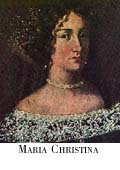
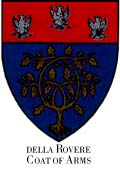 Maria Cristina, Countess Altemps m. 1646 Ipollito, Duke Lante della Rovere
Maria Cristina, Countess Altemps m. 1646 Ipollito, Duke Lante della Rovere

Antonio, Duke Lante m. 1682 Angelique, Princesse de La Tremouille

Marie Anne Lante m. Jean Baptiste, Duke of Croy Havre

Louis, Duke of Croy Havre m. 1736 Marie Louise, Princess of Montmorency
Luxembourg

Joseph, Duke of Croy Havre m. 1762 Adelaide, Princess of Croy Solre

Adelaide, Duchess of Croy Havre m. 1788 Emanuel, Prince of Croy Solre

Constance, Princess of Croy Solre m. 1810 Ferdinand, Duke of Croy

Augusta, Duchess of Croy m. 1836 Alfred, Prince of Salm Salm

Alfred, Prince of Salm Salm m. 1869 Rosa, Countess Lutzow

Emanuel, Prince of Salm Salm m. 1902 Christina von Hapsburg, Archduchess
of Austria

Rosemary, Princess of Salm Salm m. 1926 Hubert Salvator von Hapsburg,
Archduke of Austria

ANOTHER EXAMPLE OF ALESSANDRO'S DESCENT:
Joseph, Duke of Croy Havre m. 1762 Adelaide, Princess of Croy Solre

Amalie, Duchess of Croy Havre m. 1790 Charles, Marquis of Conflans

Amalie de Conflans m. 1823 Eugene, Prince of Ligne

Henri, Prince of Ligne m. 1851 Marguerite, Countess of Talleyrand Perigord

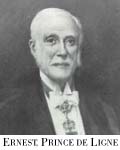
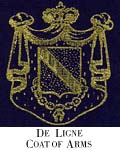 Ernest Louis, Prince of Ligne m. 1887 Diane Marchioness of Cosse Brissac
Ernest Louis, Prince of Ligne m. 1887 Diane Marchioness of Cosse Brissac

Eugene, Prince of Ligne m. 1917 Phillipine, Princess Noailles

Yolanda, Princess of Ligne m. 1950 Karl von Hapsburg, Archduke of Austria

ANOTHER EXAMPLE OF ALESSANDRO'S DESCENT:
Giulio de Medici, Knight Commander of the Gallery of St. Stephen
m. Lucrezia, Countess Gaetani

Cosimo de Medici (illegitimate) m. Lucrezia, Countess Gaetani

Angelica de Medici m. Gianpetro, Count Altemps

Maria Cristina, Countess Altemps m. 1646 Ipollito, Duke Lante della Rovere

Antonio, Duke Lante m. 1682 Angelique, Princesse de La Tremouille

Luigi, Duke Lante m. Angela, Princess Vaini

Fillipo, Duke Lante m. Faustina, Marchioness Caprianca

Maria Christina Lante m. Averado, Duke Salviati

Anna Maria Salviati m. Marcantonio , Prince Borghese

Camillo, Prince Borghese m. 1803 Pauline Bonaparte,
Napoleon's Sister

ANOTHER EXAMPLE OF ALESSANDRO'S DESCENT:
Marie Anne Lante m. Jean Baptiste, Duke of Croy Havre

Adelaide, Croy Havre m. Emanuel, Prince of Croy Solre

Constance, Princess of Croy Solre m. 1810 Ferdinand of Croy Solre

Juste Marie, Prince of Croy m. 1854 Marie, Countess Ursel

Charles, Prince of Croy m. 1896 Matilda, Countess Robiano

Marie Imaculee m. 1926 Thiery, count of Limburg Stirum

Evrard, Count of Limburg Stirum m. 1957 Helen, Princess of France daughter of the Count of Paris
Researched and Written by Mario de Valdes y Cocom an historian of the African
diaspora.
|